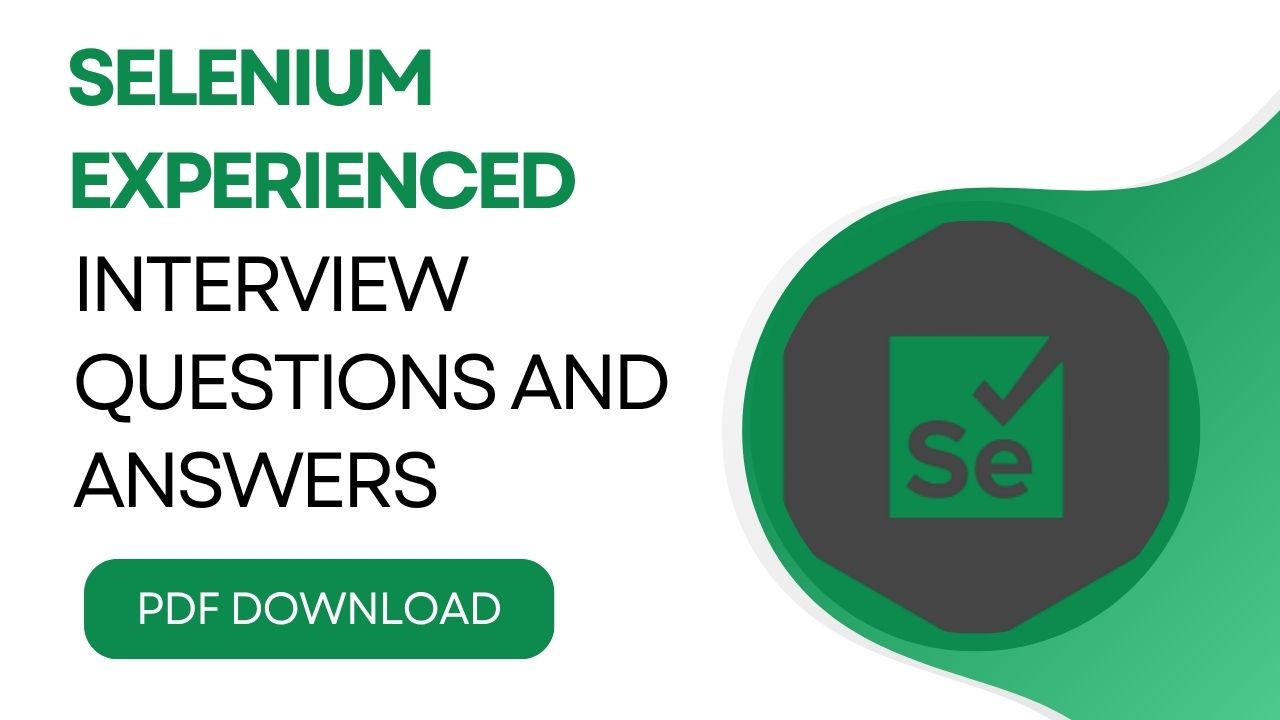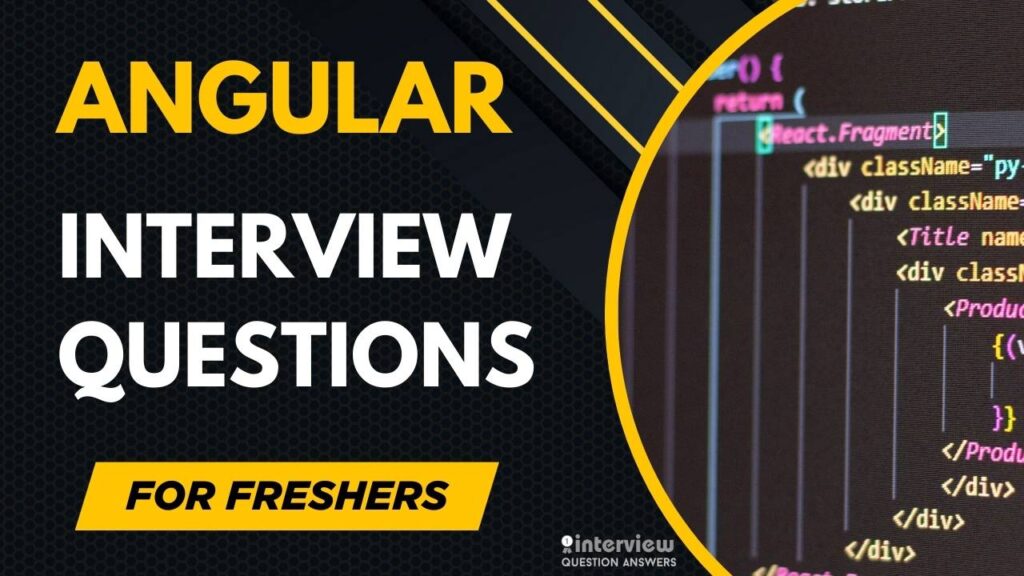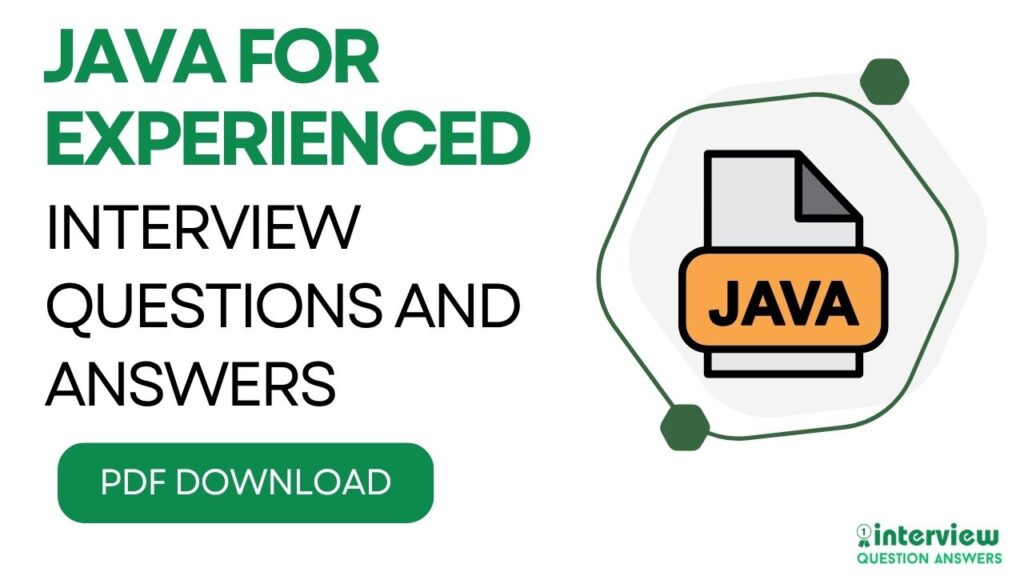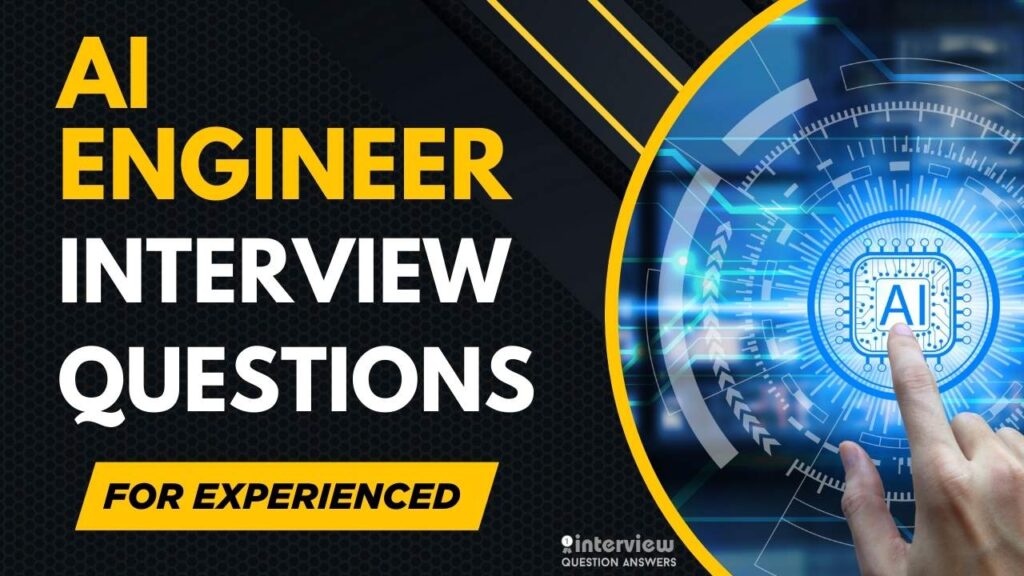Selenium automation engineers drive quality assurance processes by creating comprehensive test frameworks that validate web applications across multiple browsers and platforms using industry-leading automation tools.
They design robust test scripts, implement data-driven testing strategies, integrate continuous integration pipelines, and maintain complex automation suites that ensure software reliability and performance.
Senior Selenium engineers must demonstrate advanced framework design skills, leadership capabilities, and deep technical expertise to secure roles that match their experience level.
This selenium interview questions and answers guide targets experienced Selenium professionals with detailed questions and expert-level answers crafted specifically for candidates with 3, 5, and 10 years of hands-on automation experience. We focus on advanced topics including framework architecture, performance optimization, team leadership scenarios, and complex integration challenges that senior professionals encounter in their roles.
Table of Contents
Selenium Interview Questions and Answers for 3 Years Experience
Que 1. What are different types of locators in Selenium?
Answer: Selenium provides multiple locators to identify elements:
- id
- name
- className
- tagName
- linkText and partialLinkText
- cssSelector
- xpath
Que 2. What is the difference between findElement() and findElements()?
Answer:
- findElement() returns the first matching element and throws NoSuchElementException if not found.
- findElements() returns a list of matching elements and returns an empty list if no elements are found.
Que 3. How do you handle dropdowns in Selenium?
Answer: Dropdowns can be handled using the select class:
Select dropdown = new Select(driver.findElement(By.id("country")));
dropdown.selectByVisibleText("India");
dropdown.selectByIndex(2);
dropdown.selectByValue("ind");Que 4. What is the difference between driver.close() and driver.quit()?
Answer:
- close() closes the current browser window.
- quit() closes all browser windows and ends the WebDriver session.
Que 5. How do you handle dynamic web elements?
Answer: Use relative XPath or CSS with dynamic attributes. Example:
driver.findElement(By.xpath("//div[contains(@class,'dynamic-class')]"));Or use starts-with/contains methods to identify changing attributes.
Que 6. What are implicit, explicit, and fluent waits?
Answer:
- Implicit Wait: Sets a default wait time for all elements (e.g., driver.manage().timeouts().implicitlyWait(10, TimeUnit.SECONDS);).
- Explicit Wait: Waits for a specific condition using WebDriverWait.
- Fluent Wait: Similar to explicit wait but allows polling frequency and ignoring exceptions..
Que 7. How do you handle multiple windows in Selenium?
Answer:
String parent = driver.getWindowHandle();
Set<String> windows = driver.getWindowHandles();
for(String handle : windows) {
if(!handle.equals(parent)) {
driver.switchTo().window(handle);
}
}Que 8. How do you perform mouse hover in Selenium?
Answer: Use the Action class:
Actions actions = new Actions(driver);
actions.moveToElement(driver.findElement(By.id("menu"))).perform();Que 9. What is the difference between absolute and relative XPath?
Answer:
- Absolute XPath: Starts from the root /html/body/… and is brittle.
- Relative XPath: Starts from anywhere using //tagname[…] and is more flexible.
Que 10. How do you handle alerts and popups?
Answer:
Alert alert = driver.switchTo().alert();
alert.accept(); // for OK
alert.dismiss(); // for Cancel
alert.sendKeys("Text"); // for prompt alertsQue 11. Can you run Selenium tests in parallel?
Answer: Yes, using TestNG or JUnit frameworks. With TestNG, you can define parallel=”tests” or parallel=”methods” in testng.xml to run tests concurrently.
Que 12. How do you capture screenshots in Selenium?
Answer:
TakesScreenshot ts = (TakesScreenshot) driver;
File src = ts.getScreenshotAs(OutputType.FILE);
FileUtils.copyFile(src, new File("screenshot.png"));Que 13. How do you handle iframes in Selenium?
Answer:
driver.switchTo().frame("frameName");
driver.switchTo().frame(0); // by index
driver.switchTo().defaultContent(); // back to main pageQue 14. What are StaleElementReferenceException and its handling?
Answer: It occurs when the element is no longer attached to the DOM. To handle:
- Re-locate the element before interacting.
- Use ExpectedConditions.refreshed in explicit waits.
Que 15. How do you perform drag-and-drop in Selenium?
Answer:
WebElement source = driver.findElement(By.id("drag"));
WebElement target = driver.findElement(By.id("drop"));
Actions actions = new Actions(driver);
actions.dragAndDrop(source, target).perform();Que 16. Explain Page Object Model (POM) and its advantages.
Answer: POM is a design pattern where each page is represented as a class with web elements and methods.
Advantages:
- Reusability of code
- Improved readability and maintainability
- Centralized management of locators
Que 17. How do you validate broken links using Selenium?
Answer: Collect all links with driver.findElements(By.tagName(“a”)) and check response codes using HttpURLConnection for each link..
Que 18. How do you run Selenium tests in headless mode?
Answer: Use headless options for Chrome or Firefox:
ChromeOptions options = new ChromeOptions();
options.addArguments("--headless");
WebDriver driver = new ChromeDriver(options);Answer:
| Method | Returns |
|---|---|
| getText() | Visible inner text of the element |
| getAttribute(“value”) | Value of the specified attribute (e.g., input field value) |
Que 20. How do you integrate Selenium with CI/CD tools like Jenkins?
Answer:
- Install Jenkins and configure required plugins.
- Create a Jenkins job and link your code repository (Git).
- Add build steps to execute Maven/TestNG scripts.
- Configure test reports and schedule jobs.
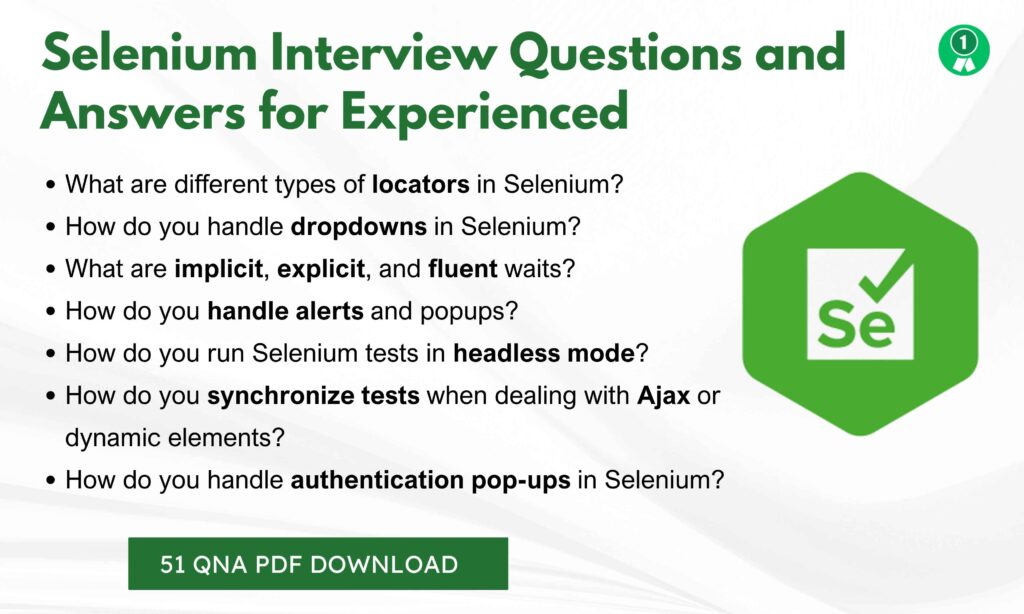
Also Check: API Testing Interview Questions and Answers
Selenium Interview Questions and Answers for 5 Years Experience
Que 21. What are the advantages and disadvantages of using XPath in Selenium?
Answer:
Advantages:
- Can navigate both forward and backward in the DOM.
- Useful for locating dynamic elements.
- Supports complex queries with functions like contains, starts-with.
Disadvantages: - Slower compared to CSS selectors.
- Can break if DOM structure changes frequently.
Que 22. How do you synchronize tests when dealing with Ajax or dynamic elements?
Answer:
- Use Explicit Waits with ExpectedConditions.
- Use Fluent Waits for polling dynamic elements.
Example:
WebDriverWait wait = new WebDriverWait(driver, 20);
wait.until(ExpectedConditions.visibilityOfElementLocated(By.id("ajaxElement")));Que 23. What is the difference between driver.get() and driver.navigate() ?
Answer:
- get() loads the page and waits until the page is completely loaded.
- navigate().to() is similar but allows using back(), forward(), and refresh() methods.
Que 24. How do you handle authentication pop-ups in Selenium?
Answer:
- Use the URL format: http://username:password@site.com
- Or handle using Alert interface if it’s a basic authentication pop-up.
- For advanced pop-ups, integrate tools like AutoIT, Robot class, or Sikuli.
Que 25. How do you implement Data-Driven Testing in Selenium?
Answer:
- Use Apache POI for Excel, or CSV, or Database integration.
- Frameworks like TestNG or JUnit can provide @DataProvider or parameterization.
Example:
@DataProvider(name = "data")
public Object[][] dataProvider() {
return new Object[][] {{"user1", "pass1"}, {"user2", "pass2"}};
}Que 26. What is the difference between CSS Selector and XPath?
Answer:
| Feature | CSS Selector | XPath |
|---|---|---|
| Speed | Faster | Slower |
| Direction | Forward only | Forward & backward |
| Syntax | Simple | Complex for beginners |
| Browser Support | All modern browsers | All modern browsers |
Que 27. How do you handle file uploads in Selenium?
Answer:
- If the element is ,<input type=”file”> use sendKeys(filePath).
driver.findElement(By.id("upload")).sendKeys("C:\\file.txt");- If it’s a custom upload window, use Robot Class, AutoIT, or Sikuli.
Que 28. What is the purpose of DesiredCapabilities in Selenium?
Answer: DesiredCapabilities is used to set properties like browser name, version, platform, or custom configurations when launching browsers, especially in RemoteWebDriver or Selenium Grid.
Que 29. How do you handle Shadow DOM elements in Selenium?
Answer: Selenium alone cannot pierce Shadow DOM. We use JavaScript Executor:
WebElement shadowHost = driver.findElement(By.cssSelector("#shadow-host"));
SearchContext shadowRoot = shadowHost.getShadowRoot();
WebElement shadowElement = shadowRoot.findElement(By.cssSelector("#inner"));Que 30. How do you handle stale elements in Selenium automation?
Answer:
- Re-locate elements after page refresh.
- Use ExpectedConditions.refreshed in Explicit Waits.
- Avoid holding elements in variables for too long if the DOM changes.
Que 31. What is Selenium Grid and when would you use it?
Answer: Selenium Grid is used to run tests in parallel on multiple machines and browsers. It supports distributed execution, saving time and improving test coverage across environments.
Que 32. How do you test responsive web designs with Selenium?
Answer:
- Change browser window size using Actions.dragAndDrop()driver.manage().window().setSize().
- Use tools like BrowserStack, Sauce Labs, or Selenium Grid for multiple device/browser combinations.
Que 33. How do you manage cookies in Selenium?
Answer:
// Add cookie
driver.manage().addCookie(new Cookie("name", "value"));
// Get cookie
Cookie cookie = driver.manage().getCookieNamed("name");
// Delete cookie
driver.manage().deleteCookie(cookie);Que 34. How do you handle complex drag-and-drop using Selenium when Actions.dragAndDrop() fails?
Answer:
- Use JavaScript Executor for custom drag-drop events.
- Break down into clickAndHold(), moveToElement(), and release() using Actions class.
Que 35. How do you generate logs in Selenium frameworks?
Answer: Use logging frameworks such as Log4j, SLF4J, or TestNG Reporter. Example with Log4j:
Logger log = LogManager.getLogger(TestClass.class);
log.info("Test started");Que 36. How do you capture network traffic using Selenium?
Answer:
- Integrate with BrowserMob Proxy or Selenium 4 DevTools APIs.
Example with DevTools:
DevTools devTools = ((HasDevTools)driver).getDevTools();
devTools.createSession();
devTools.send(Network.enable(Optional.empty(), Optional.empty(), Optional.empty()));Que 37. What is the difference between Soft Assert and Hard Assert in Selenium TestNG?
Answer:
- Hard Assert: Stops test execution if assertion fails.
- Soft Assert: Logs failures but continues execution until assertAll() is called.
Que 38. How do you test if elements are properly loaded in Single Page Applications (SPA)?
Answer:
- Use explicit waits with conditions like elementToBeClickable or invisibilityOfLoader.
- Wait for network calls to finish using Selenium DevTools or JavaScript Executor with document.readyState.
Que 39. How do you integrate Selenium with CI/CD pipelines?
Answer:
- Add the project to Jenkins, GitLab CI, or Azure DevOps.
- Configure dependencies using Maven/Gradle.
- Set up triggers for test execution on code commits and generate reports using Allure, Extent Reports, or TestNG Reports.
Que 40. How do you handle flakiness in Selenium tests?
Answer:
- Use appropriate waits instead of Thread.sleep().
- Isolate environment dependencies.
- Retry failed tests using TestNG IRetryAnalyzer.
- Stabilize locators using robust XPath/CSS.
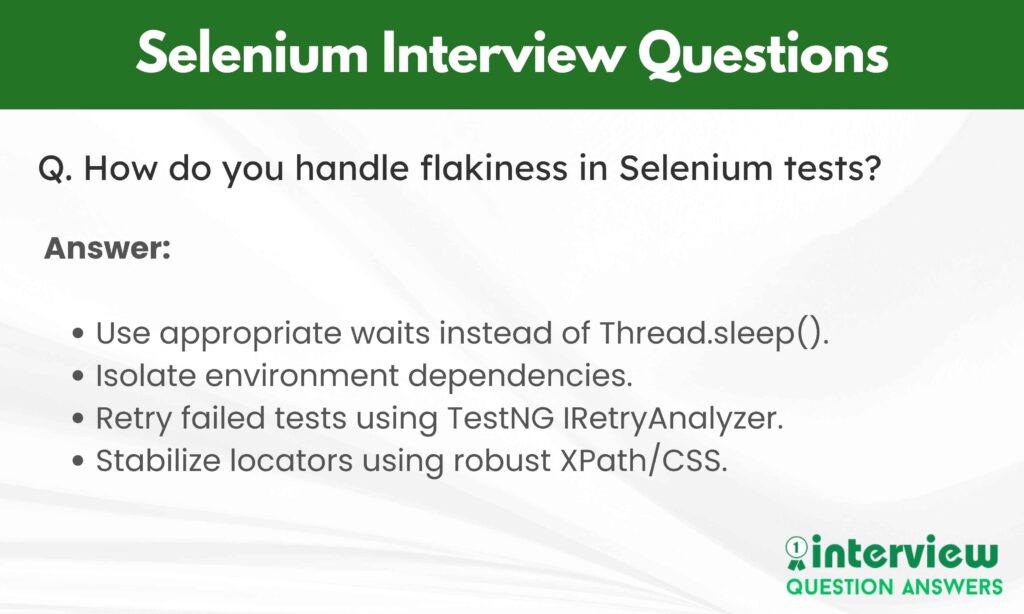
Also Check: Full Stack Developer Interview Questions
Selenium Interview Questions and Answers for 10 Years Experience
Que 41. How do you design a scalable Selenium test automation framework?
Answer: A scalable framework should follow modular design, Page Object Model (POM) or Page Factory, support multiple environments, integrate with CI/CD tools, and have reusable utilities. Key components:
- Test Data Management: Externalized data (Excel, JSON, DB).
- Parallel Execution: Selenium Grid or cloud solutions.
- Reporting: Extent Reports, Allure.
- Build Tool: Maven/Gradle for dependency management.
Que 42. How do you handle test dependencies across multiple test classes?
Answer: Use TestNG annotations like dependsOnMethods or dependsOnGroups to manage dependencies. Alternatively, implement proper test setup in @BeforeSuite or @BeforeClass and tear-down in @AfterSuite to isolate dependencies.
Que 43. How would you integrate Selenium with BDD tools like Cucumber?
Answer:
- Write test scenarios in Gherkin language.
- Map Gherkin steps to Java methods using Step Definitions.
- Use Runner classes with @CucumberOptions to integrate with JUnit/TestNG.
- Maintain Page Objects for better reusability.
Que 44. How do you handle Selenium tests running in parallel across multiple browsers and OS?
Answer:
- Use Selenium Grid, Dockerized Selenium Hub & Nodes, or cloud platforms (BrowserStack, Sauce Labs).
- Define browser configurations using DesiredCapabilities or Selenium 4 Options.
- Manage test execution with TestNG parallel attributes in testng.xml.
Que 45. How do you validate UI and functional consistency across different screen resolutions?
Answer:
- Dynamically resize browser windows using:
driver.manage().window().setSize(new Dimension(1280, 720));- Integrate visual testing tools like Applitools, Percy, or integrate image comparison libraries.
- Run tests across device emulators with Chrome DevTools or cloud services.
Que 46. How do you implement robust error handling and retry mechanisms in Selenium tests?
Answer:
- Use try-catch blocks for controlled exception handling.
- Implement TestNG IRetryAnalyzer for retrying failed tests.
- Create custom wrapper methods for WebDriver actions with retry logic.
Que 47. How do you handle Shadow DOM, nested iframes, and dynamic web components together?
Answer:
- Access nested iframes using chained switchTo().frame().
- For Shadow DOM:
WebElement shadowHost = driver.findElement(By.cssSelector("#shadowHost"));
SearchContext shadowRoot = shadowHost.getShadowRoot();- Combine both using dynamic locators and JS Executor for complex hierarchies.
Que 48. How would you capture and validate network traffic or API calls during Selenium tests?
Answer:
- Integrate Selenium 4 DevTools Protocol (CDP) to intercept requests/responses.
- Use BrowserMob Proxy or Mitmproxy for older Selenium versions.
- Validate API response codes, headers, and payloads along with UI actions.
Que 49. How do you achieve CI/CD integration with Docker and Selenium?
Answer:
- Dockerize Selenium Grid Hub and Nodes using official images.
- Use docker-compose to run containers in parallel.
- Integrate with Jenkins/GitLab pipelines to trigger containerized Selenium tests.
Que 50. How do you design data-driven and keyword-driven hybrid frameworks?
Answer:
- Data-Driven: Externalize test data using Excel/JSON/DB and feed into tests using DataProviders.
- Keyword-Driven: Define action keywords like click, enterText, and map them to methods.
- Hybrid: Combine both for maximum flexibility.
Que 51. How do you handle flaky tests and ensure stability in large-scale test suites?
Answer:
- Identify root causes (poor locators, synchronization issues).
- Use custom wait strategies instead of Thread.sleep().
- Isolate environment dependencies (mock APIs, stable test data).
- Implement test retry logic with reporting.
- Continuously monitor tests with dashboards to detect patterns.
Also Check: Python Interview Questions and Answers
Selenium Interview Questions for Experienced PDF
We provide a downloadable PDF version that enables focused preparation for senior-level Selenium automation positions.
FAQs: Selenium Interview Questions for Experienced
What is the typical job role of a Selenium Automation Engineer?
Selenium Automation Engineers are responsible for designing, developing, and maintaining automated test scripts to validate web applications. They collaborate with developers and QA teams, create reusable test frameworks, execute regression tests, and ensure software quality across various browsers and platforms.
What challenges can one face in a Selenium Automation job?
Challenges include handling dynamic elements, synchronization issues, managing test data, maintaining large test suites, and dealing with flaky tests. Engineers also face complexities while integrating with CI/CD pipelines, third-party APIs, and ensuring test stability in different environments.
What challenges might candidates face during a Selenium interview?
Candidates often face scenario-based questions that test practical experience, such as handling Shadow DOM, dynamic elements, or designing a scalable automation framework. They may also be asked about advanced topics like Selenium Grid, CI/CD integration, and debugging flaky tests.
What is the average salary of a Selenium Automation Engineer in the USA?
The average salary for a Selenium Automation Engineer in the USA ranges from $90,000 to $125,000 per year, depending on experience, location, and company size. Senior automation engineers or leads can earn $130,000+ annually.
What skills are required to succeed in a Selenium automation role?
Strong knowledge of Selenium WebDriver, Java/Python, test frameworks (TestNG, JUnit), CI/CD tools, and automation best practices are essential. Experience with API testing, BDD tools like Cucumber, cloud testing platforms, and version control (Git) adds significant value.
Which top companies hire Selenium Automation Engineers?
Top tech companies like Amazon, Google, Microsoft, Meta, IBM, Infosys, Accenture, and TCS hire Selenium Automation Engineers. Many startups and product-based companies also rely heavily on Selenium automation.
How can you grow your career as a Selenium Automation Engineer?
To grow, one should move from basic test scripting to designing robust frameworks, integrating advanced tools, and adopting DevOps practices. Certifications in automation testing, learning performance/API testing, and mentoring teams can lead to senior roles such as QA Architect or Automation Lead.

